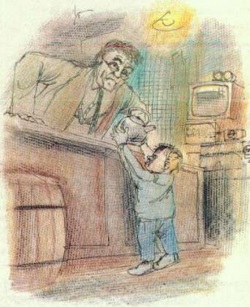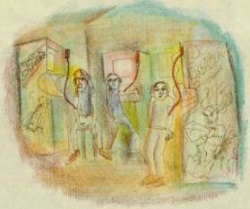

In the first of an occasional series examining the far-reaching effects of computers on today’s society, Mel Croucher uncovers the truth about:

True or false? Five Cheltenham boys tried to commit mass suicide after becoming addicted to Space Invaders, True or false? Over 200 Tokyo boys have turned to prostitution in order to raise cash to feed arcade games. True or false? A Danish student has been committed to a mental hospital because he thinks he has turned into a computer. True or false? An American boy murdered a child because he was ordered to buy a game of Dungeons And Dragons, True or false? Over £3 million is spent in British video arcades every day. True or false?
People have been arguing for years about whether or not there are any dangerous side-effects from playing video games. In fact there has been more rubbish written about this subject than any other aspect of computerised entertainment. MONITOR does not intend to ram any opinions down your throat: it simply gives you the facts. Now you can make up your own mind...
Video arcades make money. Loadsa money! Last year over £1,300,000,000 was eaten by hungry video arcade slots. And before you write in to CRASH, I promise you that I haven’t stuck on any extra zeroes to that incredible figure. The police confirm that these arcades are also used as centres for drug pushing, flogging off stolen gear and as pick-up joints for young male prostitutes. Even though ‘underage’ players are illegal, a South Coast arcade operator has admitted to me that eight out of ten people who use video arcades in his resort are under 18 years old. But even if they are banned from the arcades, the younger kids are also much more likely to come across video games, which are common in cafes and chippies, than fruit machines, which are age-restricted to pubs, clubs and those wicked video dens.
In the average British home, the computer has the following effect on a ‘normal’ user: it begins by replacing most other social events and is used more than 15 hours a week. After three months, the average use of a home micro or games console falls to a round 6 hours. After a year, 35% of machines are gathering dust and hardly ever get used. The number of games owned by a player has no link whatsoever with the number of hours spent playing them. Games players’ popularity is not affected — in fact you tend to get more popular with your mates in the first three months of micro ownership. None of the computer users and video games players in the survey dropped marks at school while they were involved with playing, which should please my readers. Unfortunately you won’t be pleased to learn that video games players had lower average marks than non-players, both before and after the survey. So much for ‘normal’ players.
‘Arcade Addiction’ and ‘Computer Addiction’ takes hold when a games player becomes so involved with the machine that other aspects of his life begin to suffer. The subject has been very carefully researched by the British Journal of Criminology.
Addiction often begins when a player starts to miss school in favour of playing video games, and addicts are likely to go without food so they can afford more plays. A ‘Criminal Player’ is anyone who has stolen money for the sole purpose of feeding the machines, and that’s about 14% of all players. According to The Times, last December one kid got into the habit of flogging off the family furniture to afford his video habit. When he sold the kettle, his mum put the saucepan on for a cup of tea, but when she came back into the kitchen it had disappeared! Junior had nicked it and given a whole new meaning to hot goods.
Criminal players and video addicts in Europe, Japan and the USA all begin to play video games at a much earlier age than ‘normal’ players. They play more frequently, and they spend all of their money on their habit. When the addiction really bites, regular thieving becomes a habit, and players are wide open to getting money through dealing in drugs and flesh. In 1987 the Amusement Arcade Action Group was formed to try and stop the problem spreading, but so far there has been no improvement at all. The general public doesn’t regard it as a serious problem; and why should they when most parents gamble, either by doing the pools, betting on the horses or playing video and fruit machines themselves. CRASH readers are well aware that video games are a new phenomenon — you are the first generation who has widespread experience of them. Arcades, friends’ rooms and other playing areas provide a space which is free from the usual prying eyes of parents, teachers and other figures of authority. This is also one of the main reasons for players selling up their own ‘tribes’, just like on the football terraces, with leaders emerging from their playing skills, as opposed to the size of their fists and the thickness of their skulls.
A classic case of a small tribe of video addicts coming to grief happened place in Cheltenham. Five friends, all aged 17 or 18 got into a Space Invaders habit that was costing them over £100 a week. The debts started to pile up and soon became serious, but instead of looking for help the group decided that their only way out was mass suicide. They had become so involved in their own world of machines and arcades that they lost touch with reality, even to the point of having their own coded phrases and secret language. The gang of five did indeed try to kill themselves with an overdose of commonly prescribed drugs, and it was only because of a desperate call to the Samaritans that they were saved.

Recent events in the States have proved more sinister: David Ventiqualiro is a 16 year-old who has just been jailed for between 5 years and life for killing 11-year-old Martin Houtand. The Prosecution proved that the death was linked to a computerised version of Dungeons And Dragons, where the murderer believed that the game had revealed to him that Martin was an evil enemy, and instructed him ‘to extinguish the evil’.
In March of last year Westminster City Council took an outfit called the British Amusement Catering Arcades to court, worried that young kids were being abused, in every sense of the word, in video arcades. They won their case, proving that ‘video games constitute an exhibition of moving pictures, for the purpose of the Cinema Act of 1909’ and ‘an exhibition of moving pictures other than by the reception and exhibition of television programs, under the Cinema Amendment Act of 1982’! What all that means is that video arcades needs licenses just like cinemas, and underage kids are not allowed to use them — but everyone knows that most video arcades ignore the law, don’t they?
Now we’ve all heard the arguments, whether it’s about video nasties triggering off the Hungerford massacre, or disembowelling prostitutes in CRL’s Dracula. Some will scream that these products are cynical, corrupting and ‘evil’. Others will yell that they are positively beneficial. Indeed, Infogrames’ Pauline Garsden has issued a challenge through the trade paper Computer Trade Weekly for anyone to produce evidence of computer games having a directly harmful effect on a kid, and she will write out a cheque to Save The Children. So far nobody has come up with the evidence. Sorry Pauline, but it’s time to get your cheque book out.

On September 8 1987, an 18-year-old Danish male was committed to a Copenhagen mental hospital. Since the age of ten he has spent most of his time playing with his father’s computer equipment, and for the last three years he has been addicted to computer games, playing from 12 to 16 hours a day. The games have replaced his friends and family, and dominate his life completely. The reason he has been removed to a psychiatric ward is that he now believes he is a computer, and has been diagnosed as the first sufferer from a new derangement which translates from the Danish as ‘obsessive mechanical mentality’. He can no longer communicate with human beings; he thinks in code and he believes that he has turned into a computer.
This sad case is an extreme example of computer addiction, but most of us know at least one person who suffers to a lesser extent; the quiet kid who spends hours locked up in her/his room eyes glued to the monitor, finding an artificial security in an electronic world. And the computer addict is much more likely to be an introvert than a paranoid and violent psychotic. As far back as 1982, the British Film Institute’s education boffins proved that far from violent games turning kids into aggressive monsters, shoot ’em up players were less aggressive than children who spent their time watching televised soaps and game shows. Mind you, anyone who hasn’t felt like sticking their boot through a televised Bob Monkhouse or Black Forest Clinic really needs their head examining.
Take a look at the following lumps of research, and see if you know anyone who fits into any of the categories:
Reports show that levels of aggression in video games have a direct effect on violent behaviour during and immediately after play, and that girls are affected more than boys! Also, watching aggressive games has the same effect as actually playing them.
In the USA a detailed survey has proved that video gamers are more impulsive and less intelligent that non-gamers. In the UK a similar survey shows that the main reasons for playing video games are excitement, gaining personal satisfaction and being influenced by friends, but that video gainers achieve worse grades in English than non-players.
Unlike alcoholics, drug addicts and gamblers, video game addicts have the lowest awareness of their problem. In fact seven out of ten video game addicts deny that they are addicts at all. They don’t see any relationship between their video habit and the most frequent problems of addiction: stealing, neglecting food, getting into debt, cutting off from family and friends, missing school or work, and involvement with drugs and prostitution to feed their video game habit.
The American Academy of Child Psychology states that heavy involvement with video games leads to a lower frustration tolerance, and players are much more likely to lose their temper. They also develop an unrealistic sense of their own mastery. In the over-18 age group, males tend to confuse fantasy and reality much more than female players, especially when involved with role-playing games.
Video games improve eye/hand co-ordination, reaction time and other skills in the over-60 age group, during recovery from illness. They also help the over-70s to improve their driving habits, and geriatric video games players have fewer minor accidents in the house.
In certain cancer treatments, they are necessary to control vomiting. Video games have been successfully used to concentrate cancer patient’s minds away from wanting to throw up, and have helped to lessen feelings of anxiety during cancer treatment.
The Journal of Child Studies states that video gamers are more confident than non-gamers and are less likely to suffer from tension.
I have already told you that 70% of computer addicts don’t know they’ve been hooked, but if you are worried by some of these facts you can set your mind at rest by answering a few questions for yourself.

Remember, most computer addicts never admit to themselves that they are in trouble, so if you have answered ‘YES’ to more than TEN of these questions, you may have a problem. If your video game habit has got you into theft, or illegal dealing, or if you have got into any debt, you have definitely got a problem. There are any number of agencies that can help, and if you find it impossible to talk to parents, teachers or friends who are not involved with your video gaming, you can phone the Samaritans or Child line in complete secrecy. They should be in your phone book, but if you don’t know how to get in touch, contact your nearest Citizens Advice Bureau, which is there to help and will tell you how to contact the Help Lines in your area.
In the next bi-monthly MONITOR, Mel Croucher lays down the facts of an even more serious problem: KILLER COMPUTERS.